(完整word版)小学英语全部语法知识点整理
(完整word版)外研版小学英语语法总复习知识点归纳
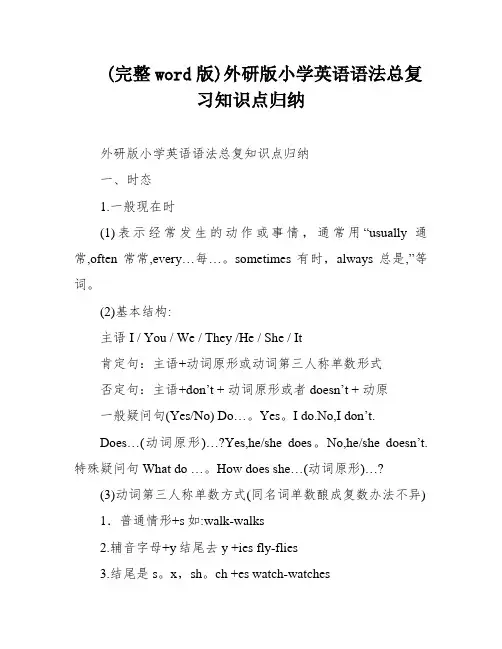
(完整word版)外研版小学英语语法总复习知识点归纳外研版小学英语语法总复知识点归纳一、时态1.一般现在时(1)表示经常发生的动作或事情,通常用“usually通常,often常常,every…每…。
sometimes有时,always总是,”等词。
(2)基本结构:主语I / You / We / They /He / She / It肯定句:主语+动词原形或动词第三人称单数形式否定句:主语+don’t + 动词原形或者doesn’t + 动原一般疑问句(Yes/No) Do…。
Yes。
I do.No,I don’t.Does…(动词原形)…?Yes,he/she does。
No,he/she doesn’t.特殊疑问句What do …。
How does she…(动词原形)…?(3)动词第三人称单数方式(同名词单数酿成复数办法不异)1.普通情形+s如:walk-walks2.辅音字母+y结尾去y +ies fly-flies3.结尾是s。
x,sh。
ch +es watch-watches4.结尾是0 +es do-does。
go-goes5.特殊have-has2.现在进行时(1)表示正在发生的动作,通常用“now现在。
look看,XXX听”.(2)根本方式: be +动词-ingeg: I am(not) XXX.You/We/They are(not) reading。
He/She/It is(not) eating.What are you doing。
Is he reading?(3)动词的目前分词方式(动词+ing)普通情形+ing walk—walking末端是不发音的e-e+ingcome—coming重读闭音节双写末了一个字母+ingswim-swimming。
run-running3.一般过去时(1)表示过去已经发生的事情,通常用“last …上一个…。
just now刚才,many years ago许多年前,XXX昨天”等词。
(完整word版)小学英语语法大全(绝对全面)(可编辑修改word版)
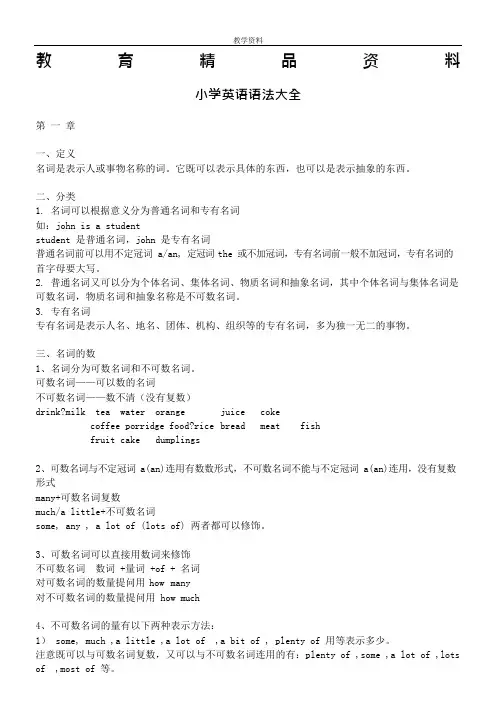
教育精品资料小学英语语法大全第一章一、定义名词是表示人或事物名称的词。
它既可以表示具体的东西,也可以是表示抽象的东西。
二、分类1.名词可以根据意义分为普通名词和专有名词如:john is a studentstudent 是普通名词,john 是专有名词普通名词前可以用不定冠词 a/an, 定冠词 the 或不加冠词,专有名词前一般不加冠词,专有名词的首字母要大写。
2.普通名词又可以分为个体名词、集体名词、物质名词和抽象名词,其中个体名词与集体名词是可数名词,物质名词和抽象名称是不可数名词。
3.专有名词专有名词是表示人名、地名、团体、机构、组织等的专有名词,多为独一无二的事物。
三、名词的数1、名词分为可数名词和不可数名词。
可数名词——可以数的名词不可数名词——数不清(没有复数)drink?milk tea water orange juice cokecoffee porridge food?rice bread meat fishfruit cake dumplings2、可数名词与不定冠词 a(an)连用有数数形式,不可数名词不能与不定冠词 a(an)连用,没有复数形式many+可数名词复数much/a little+不可数名词some, any , a lot of (lots of) 两者都可以修饰。
3、可数名词可以直接用数词来修饰不可数名词数词 +量词 +of + 名词对可数名词的数量提问用how many对不可数名词的数量提问用 how much4、不可数名词的量有以下两种表示方法:1) some, much ,a little ,a lot of ,a bit of , plenty of 用等表示多少。
注意既可以与可数名词复数,又可以与不可数名词连用的有:plenty of ,some ,a lot of ,lots of ,most of 等。
如 there is much water in the bottle .瓶中有很多水。
(word完整版)小学三至六年级英语语法及重点词汇(外研版)
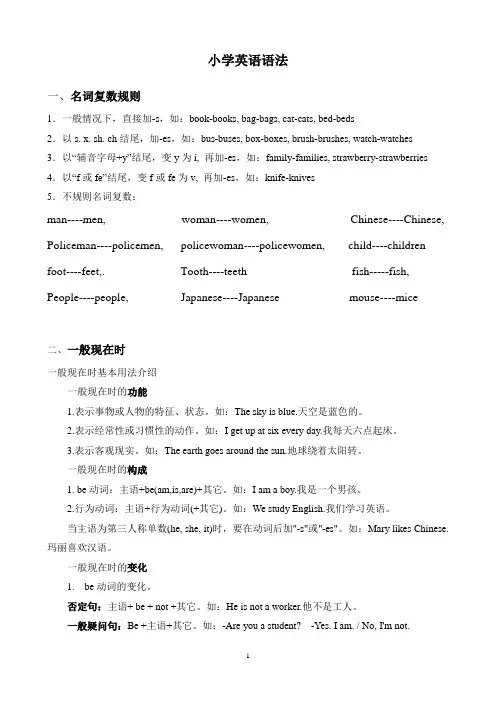
小学英语语法一、名词复数规则1.一般情况下,直接加-s,如:book-books, bag-bags, cat-cats, bed-beds2.以s. x. sh. ch结尾,加-es,如:bus-buses, box-boxes, brush-brushes, watch-watches3.以“辅音字母+y”结尾,变y为i, 再加-es,如:family-families, strawberry-strawberries 4.以“f或fe”结尾,变f或fe为v, 再加-es,如:knife-knives5.不规则名词复数:man----men, woman----women, Chinese----Chinese, Policeman----policemen, policewoman----policewomen, child----children foot----feet,. Tooth----teeth fish-----fish, People----people, Japanese----Japanese mouse----mice二、一般现在时一般现在时基本用法介绍一般现在时的功能1.表示事物或人物的特征、状态。
如:The sky is blue.天空是蓝色的。
2.表示经常性或习惯性的动作。
如:I get up at six every day.我每天六点起床。
3.表示客观现实。
如:The earth goes around the sun.地球绕着太阳转。
一般现在时的构成1. be动词:主语+be(am,is,are)+其它。
如:I am a boy.我是一个男孩。
2.行为动词:主语+行为动词(+其它)。
如:We study English.我们学习英语。
当主语为第三人称单数(he, she, it)时,要在动词后加"-s"或"-es"。
小学英语语法大全(完整版)(可打印)
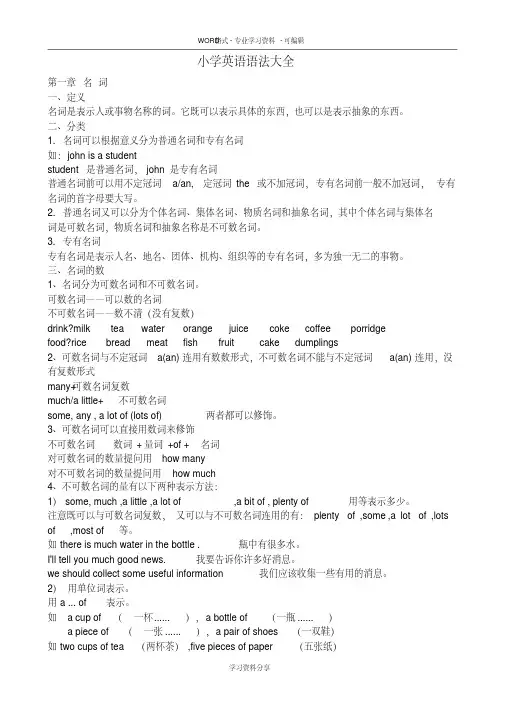
小学英语语法大全第一章名词一、定义名词是表示人或事物名称的词。
它既可以表示具体的东西,也可以是表示抽象的东西。
二、分类1. 名词可以根据意义分为普通名词和专有名词如:john is a studentstudent是普通名词,john是专有名词普通名词前可以用不定冠词a/an, 定冠词the 或不加冠词,专有名词前一般不加冠词,专有名词的首字母要大写。
2. 普通名词又可以分为个体名词、集体名词、物质名词和抽象名词,其中个体名词与集体名词是可数名词,物质名词和抽象名称是不可数名词。
3. 专有名词专有名词是表示人名、地名、团体、机构、组织等的专有名词,多为独一无二的事物。
三、名词的数1、名词分为可数名词和不可数名词。
可数名词——可以数的名词不可数名词——数不清(没有复数)drink?milk tea water orange juice coke coffee porridgefood?rice bread meat fish fruit cake dumplings2、可数名词与不定冠词a(an)连用有数数形式,不可数名词不能与不定冠词a(an)连用,没有复数形式many+可数名词复数much/a little+不可数名词some, any , a lot of (lots of) 两者都可以修饰。
3、可数名词可以直接用数词来修饰不可数名词数词 +量词 +of + 名词对可数名词的数量提问用how many对不可数名词的数量提问用 how much4、不可数名词的量有以下两种表示方法:1) some, much ,a little ,a lot of ,a bit of , plenty of 用等表示多少。
注意既可以与可数名词复数,又可以与不可数名词连用的有:plenty of ,some ,a lot of ,lots of ,most of 等。
如there is much water in the bottle .瓶中有很多水。
【最新】小学英语总结语法知识-word范文 (30页)
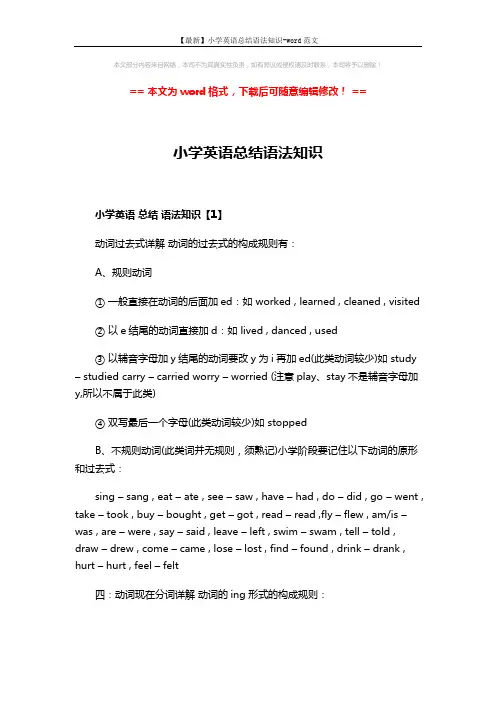
【最新】小学英语总结语法知识-word范文
本文部分内容来自网络,本司不为其真实性负责,如有异议或侵权请及时联系,本司将予以删除!
== 本文为word格式,下载后可随意编辑修改! ==
小学英语总结语法知识
小学英语总结语法知识【1】
动词过去式详解动词的过去式的构成规则有:
A、规则动词
①一般直接在动词的后面加ed:如 worked , learned , cleaned , visited
②以e结尾的动词直接加d:如 lived , danced , used
③以辅音字母加y结尾的动词要改y为i再加ed(此类动词较少)如 study – studied carry – carried worry – worried (注意play、stay不是辅音字母加y,所以不属于此类)
④双写最后一个字母(此类动词较少)如 stopped
B、不规则动词(此类词并无规则,须熟记)小学阶段要记住以下动词的原形和过去式:
sing – sang , eat – ate , see – saw , have – had , do – did , go – went , take – took , buy – bought , get – got , read – read ,fly – flew , am/is –was , are – were , say – said , leave – left , swim – swam , tell – told , draw – drew , come – came , lose – lost , find – found , drink – drank , hurt – hurt , feel – felt
四:动词现在分词详解动词的ing形式的构成规则:。
PEP小学英语语法大全(整理最全).pdf
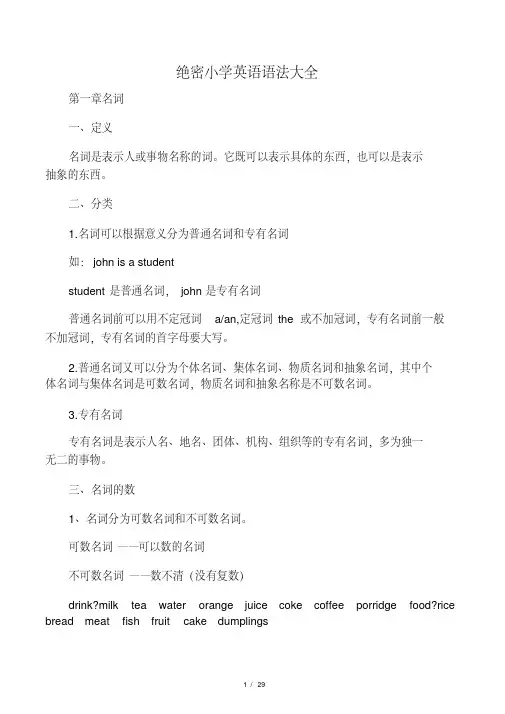
绝密小学英语语法大全第一章名词一、定义名词是表示人或事物名称的词。
它既可以表示具体的东西,也可以是表示抽象的东西。
二、分类1.名词可以根据意义分为普通名词和专有名词如:john is a studentstudent是普通名词,john是专有名词普通名词前可以用不定冠词a/an,定冠词the 或不加冠词,专有名词前一般不加冠词,专有名词的首字母要大写。
2.普通名词又可以分为个体名词、集体名词、物质名词和抽象名词,其中个体名词与集体名词是可数名词,物质名词和抽象名称是不可数名词。
3.专有名词专有名词是表示人名、地名、团体、机构、组织等的专有名词,多为独一无二的事物。
三、名词的数1、名词分为可数名词和不可数名词。
可数名词——可以数的名词不可数名词——数不清(没有复数)drink?milk tea water orange juice coke coffee porridge food?rice bread meat fish fruit cake dumplings2、可数名词与不定冠词a(an)连用有数数形式,不可数名词不能与不定冠词a(an)连用,没有复数形式many+可数名词复数much/a little+不可数名词some, any , a lot of (lots of)两者都可以修饰。
3、可数名词可以直接用数词来修饰不可数名词数词+量词+of +名词对可数名词的数量提问用how many对不可数名词的数量提问用how much4、不可数名词的量有以下两种表示方法:1)some, much ,a little ,a lot of ,a bit of , plenty of用等表示多少。
注意既可以与可数名词复数,又可以与不可数名词连用的有:plenty of ,some,alot of ,lots of ,most of等。
如there is much water in the bottle .瓶中有很多水。
(超详)小学英语知识点归纳汇总
(超详)小学英语知识点归纳汇总
1. 语法知识点
- 主谓一致:主语和谓语动词在人称和数上保持一致。
- 形容词和副词的比较级和最高级:用于比较两个或多个事物的形容词和副词的变化形式。
- 名词的单复数:名词变化形式表示单数或复数。
- 时态:表示动作发生的时间,包括现在时、过去时和将来时等。
2. 词汇知识点
- 常用的基础词汇:包括数字、颜色、家庭成员、动物、食物等基本词汇。
- 动词:常用的动词及其过去式和现在分词形式。
- 名词:常见的名词及其单数和复数形式。
- 形容词和副词:用于描述事物的形容词和表示方式的副词。
3. 句型知识点
- 祈使句:用于表达命令、请求或建议的句子。
- 选择疑问句:用于提问时给出的选择项。
- 陈述句:陈述一个事实或描述一个情况的句子。
- 疑问句:用于提出问题的句子。
4. 阅读知识点
- 词义猜测:通过上下文推测词语的意思。
- 主旨理解:理解文章的中心思想或要点。
- 细节理解:理解文章中的具体细节信息。
- 推理判断:根据已有信息推断出未提及的信息。
以上是小学英语的一些基本知识点归纳汇总,希望对您有帮助!。
完整版小学英语语法大全 .doc
小学英语语法大全一、名词复数规则1.一般情况下,直接加 -s,如: book-books, bag-bags, cat-cats, bed-beds2.以 s. x. sh. ch 结尾,加 -es ,如:bus-buses, box-boxes,brush-brushes, watch-watches3.以“辅音字母 y ”结尾,变 y 为 i, 再加-es ,如:family-families, strawberry-strawberries4.以“f或 fe ”结尾,变 f 或 fe 为 v, 再加-es ,如:knife-knives ] Leaf —— leaves5.不规则名词复数:man-men, woman-women, policeman-policemen,policewoman-policewomen,child-childrenfoot-feet,.tooth-teethfish-fish, people-people, Chinese-Chinese,Japanese-Japanese写出下列各词的复数I _________him _________this ___________her ______watch _______child _______photo ________diary ______day________ foot________ book_______ dress ________tooth_______ sheep ______box_______ strawberry _____peach______ sandwich ______dish_______bus_______man______ woman_______二、一般现在时一般现在时基本用法介绍【No. 1 】一般现在时的功能1.表示事物或人物的特征、状态。
如:The sky is blue. 天空是蓝色的。
(完整)人教版小学英语语法知识点汇总,推荐文档
目录一、音素及音标 (2)二、音节及音节的划分 (3)三、常用字母或字母组合发音规律 (4)1、元音字母及组合的发音 (4)(1)与字母a 相关的单词 (4)(2)与字母 e 相关的单词 (5)(3)与字母i 相关的单词 (6)(4)与字母o 相关的单词 (7)(5)与字母u 相关的单词 (8)2、辅音字母及组合的发音 (9)(1)单个字母 (9)(2)字母组合 (10)四、词的变式及用法 (11)1、名词及名词的复数形式 (11)2、冠词及其用法 (12)3、代词及其用法 (13)4、形容词的比较级和最高级 (14)5、介词的固定用法 (15)五、时态及语法 (16)1、一般现在时及其用法 (16)2、现在进行时 (19)3、一般将来时 (20)4、一般过去时 (21)六、常见固定词组 (23)附各专项测试习题 (24)一、音素及音标音素:英语把组成一个读音的最小单位叫音素。
因素分为元音和辅音(相当于语文中的韵母和声母)1、元音(韵母)1.1发音方式:靠声带发音,有声调,气流通过喉头、口腔不受阻碍。
元音单元音长元音[a:][ә:][i:][ɔ:][u:]短元音[Λ][ә][i][ɔ][u][æ][e]双元音[ai][ei][ɔi][iә ][eә ][uә ][au][әu]1.3元音的结构元音的常见构成有:组合方式举例1单个元音字母D o g2元音字母+元音字母S ee、s ea、m ea t、b oo k3元音字母+辅音字母T al l、pl aya e i o u2、辅音(声母)2.1发音方式:主要是用气流与牙齿舌头等其它器官摩擦发音,气流通过喉头、口腔要受到某个部位的阻碍。
辅音10对清辅音[p] [t] [k] [f] [s] [∫][t∫][tr] [θ][ts]浊辅音[b] [d] [g] [v] [z] [ʒ][dʒ][dr] [ð] [dz] 3个鼻音[m] [n] [η]3个似拼音[h] [r] [l]2个半元音[w] [j]组合方式举例1单个辅音字母D og、b ook2辅音字母+辅音字tr ee、dr aw、tea ch、sh ip26个字母中,除去5个元音字母(a、e、i、o、u),其他字母都是辅音字母。
小学英语语法大全(完整版)
小学英语语法大全第一章名词一、定义名词是表示人或事物名称的词。
它既可以表示具体的东西,也可以是表示抽象的东西。
二、分类1. 名词可以根据意义分为普通名词和专有名词如:john is a studentstudent是普通名词,john是专有名词普通名词前可以用不定冠词a/an, 定冠词the 或不加冠词,专有名词前一般不加冠词,专有名词的首字母要大写。
2. 普通名词又可以分为个体名词、集体名词、物质名词和抽象名词,其中个体名词与集体名词是可数名词,物质名词和抽象名称是不可数名词。
3. 专有名词专有名词是表示人名、地名、团体、机构、组织等的专有名词,多为独一无二的事物。
三、名词的数1、名词分为可数名词和不可数名词。
可数名词——可以数的名词不可数名词——数不清(没有复数)drink?milk tea water orange juice coke coffee porridgefood?rice bread meat fish fruit cake dumplings2、可数名词与不定冠词a(an)连用有数数形式,不可数名词不能与不定冠词a(an)连用,没有复数形式many+可数名词复数much/a little+不可数名词some, any , a lot of (lots of) 两者都可以修饰。
3、可数名词可以直接用数词来修饰不可数名词数词 +量词 +of + 名词对可数名词的数量提问用how many对不可数名词的数量提问用 how much4、不可数名词的量有以下两种表示方法:1) some, much ,a little ,a lot of ,a bit of , plenty of 用等表示多少。
注意既可以与可数名词复数,又可以与不可数名词连用的有:plenty of ,some ,a lot of ,lots of ,most of 等。
如there is much water in the bottle .瓶中有很多水。
- 1、下载文档前请自行甄别文档内容的完整性,平台不提供额外的编辑、内容补充、找答案等附加服务。
- 2、"仅部分预览"的文档,不可在线预览部分如存在完整性等问题,可反馈申请退款(可完整预览的文档不适用该条件!)。
- 3、如文档侵犯您的权益,请联系客服反馈,我们会尽快为您处理(人工客服工作时间:9:00-18:30)。
小学英语全部语法知识点整理1.人称代词主格: I we you she he it they宾格: me us you her him it them形容词性物主代词:my our your her his its their名词性物主代词: mine ours yours hers his its theirs2.形容词和副词的比较(1) 一般在形容词或副词后+erolder ,taller, longer, stronger(2) 多音节词前+moremore interesting, etc.(3) 双写最后一个字母,再+erbigger fatter, etc.(4) 把y变i,再+erheavier, earlier(5) 不规则变化:well-better, much/many-more, etc.3.可数词的复数形式Most nouns + s abook –booksNouns ending in aconsonant +y - y+ ies a story—stories Nouns ending in s,sh, ch or x + es a glass—glasses a watch-watchesNouns ending in o+s or +es a piano—pianos a mango—mangoes Nouns ending in for fe - f or fe +ves a knife –knives a shelf-shelves4.不可数名词(单复数不变)bread, rice, water ,juice等。
5.缩略形式I’m= I a,you’re = you are, she’s= she is, he’s = he is it’s= it is, who’s =who is, can’t =can not, isn’t=is not 等。
6.a/ana book, a peachan egg, an hour7.Prepositionon, in ,in front of, between, next to, near, beside, at,behind. 表示时间: at six o’clock, at Christmas, at breakfaston Monday, on 15th July, On National Dayin the evening, in December, in winter8.基数词和序数词one – first, two-second,twenty-twentieth9.some/anyI have some toys in my bedroom.Do you have any brothers or sisters?10.be动词(1) Basic form: am/are/is(2) 肯定和否定句 I am(not) from London.My eyes are(not) small.My hair is(not) long.(3)一般疑问句:Am I a Chniese? Yes, you are. No, you aren’t.Are they American? Yes, they are. No,they aren’t.Is the cat fat? Yes,it is. No, it isn’t.11.there be结构肯定句:There is a … Thereare …一般疑问句: Is there …? Yes, there is./ No, there isn’t.Arethere…? Yes, there are. /No, there aren’t.否定句: There isn’t ….Therearen’t….12.祈使句Sit down please Don’tsit down, please.13.现在进行时通常用“now”.形式: be + verb +ingeg: I am(not) doing my homework.You/We/They are(not) reading.He/She/It is(not) eating.动词—ing 的形式Most verbs +ing walk—walkingVerbs ending in e -e + ing come—comingShort verbs ending in a vowel + a consonant run –running swim —swimming14.一般现在时通常用“usually, often, every day,sometimes”。
肯定句:I go to school on foot every day.She goes to school on foot every day.一般疑问句:Do you jump high? Yes, I do. / No, I don’t.Does he jump high? Yes, he does. / No, he doesn’t.否定句: We don’t go to school on Sundays.My mother doesn’t like watching TV in the evening.15.情态动词can,must, should后面直接用动词原形。
eg: 1. I / He / She / They can sing.2.You should keep quiet in the library.16.一般过去时态(a) be 动词的过去式:I/He/she/it was(not)…. You/we/they were….一般疑问句was, were 放在句首。
(b)动词过去式:肯定句: I watched cartoons.She visited the zoo.一般疑问句:Did you read book last night? Yes, I did. No, I didn’t.Did she clean the desk just now? Yes, she did. No, shedidn’t.否定句: They didn’t go the the part yesterday.He didn’t make model ships last week.(3)动词过去式的变化:规则动词的变化:Most verbs +ed eg. planted,watered,climbed。
Verbs ending in e+d eg liked。
Verbs ending in aconsonant +y --y +ied eg : study—studiedShort verbs ending in a vowel + a consonant eg:stop --stopped 不规则动词的变化:is/am—was,are—were,do—did,have/has—had,make—made,fly-flew,eat—ate,take—took,run—ran,sing—sang,drink—drank 等等17.Wh-"questions"What are you doing?What colour is it?What time is it?/ What’s the time?Which is your watch, the yellow one or the white one?Who’sthe man with a big nose?Whose bag is it?When is your birthday?Where is my ball pen?Why do you like summer?How many books are there in the school bag?How old is the young man?How much is the toy bear?How do you go to school every day?1、一般现在时A、表示不受时限的客观存在如:He is a boy. She is a student.My mother is anurse. This is a dog. I have a book.B、表示现在的习惯动作,即指现在经常发生的动作,一般现在时常用来表示现在时间里某种动作的经常性和习惯性。
它常与表示程度或频度的词连用,如:often(经常) , usually(通常,一般) , sometimes(有时) , always(总是,一直) , never(从不)如:I often go to school on foot.My father works in a school.Mike watches TV every day.I usually playcomputer games on the weekend.C、表示现时的状态和现在瞬间动作.如:How are you? You look happy. What’s the matterwith you? I have a headache. What do you have for lunch? I have some chicken.☆注意☆英语动词的现在时与原形同形。
但当主语是第三人称单数时,须在词尾加s 或 -es。
例如:I have a fish for dinner. Her mother works in a hospital. Amy often goes to school by bike. Mr. Liu teaches us English. 加-es 的动词必须是以“sh , ch , o ”等字母结尾的。
如:watches , teaches ,goes , washes2、一般将来时表示在将来会发生的事或动作。
它常与表示将来的时间连用,如:tomorrow , next week , next year ,this morning , this afternoon , this evening 等☆注意☆一般将来时小学阶段主要学了两种结构:①be going to + 动词的原形 / 地点②will + 动词的原形例句: I’m going to go shopping thisafternoon. She is going to Hong Kong next week. You will see many birds in the sky.3、现在进行时表示说话时正在进行的动作或现阶段一直在进行的动作。
